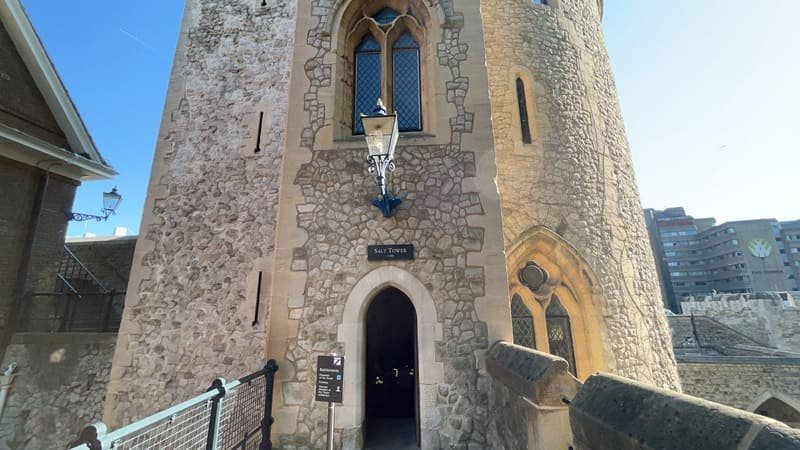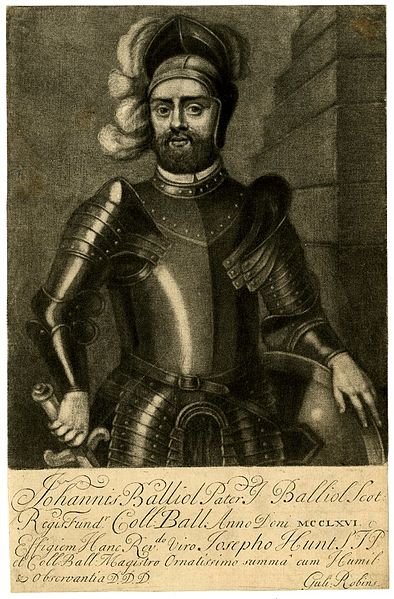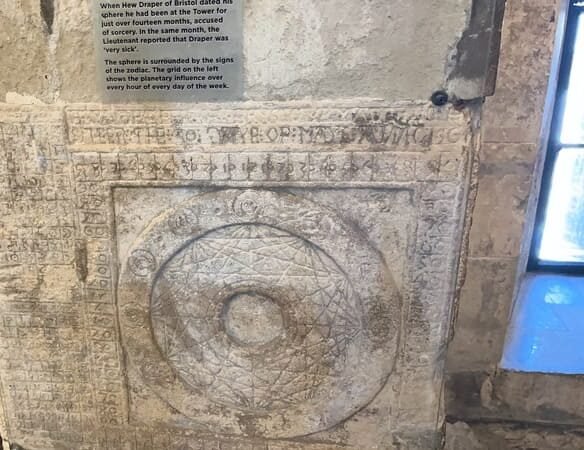
Audio Guide Script
The Salt Tower was constructed between 1238 and 1240, during the reign of King Henry III. Originally known as the Bowyer Tower, it was later renamed the Salt Tower, possibly due to its use as a storage facility for salt, a valuable commodity in medieval England.
Take a moment to appreciate the tower’s impressive architecture. With a diameter of approximately 42 feet and a height of 60 feet, this circular structure is built from Kentish ragstone. Notice the thick walls and narrow windows, designed for both defense and to provide a view of the surrounding landscape.
The Salt Tower has housed several high-profile prisoners throughout its history. Let’s explore the stories of three of its most famous occupants.
Our first notable prisoner is John Balliol, King of Scotland. Imprisoned here in 1296 for three years, Balliol’s story is one of political intrigue. Crowned at Scone in 1292, his reign was short and tumultuous. Caught between the demands of Edward I of England and his own Scottish nobles, Balliol eventually allied with France, leading to his downfall and imprisonment here in the Salt Tower.
Now, let’s move to the 16th century and the curious case of Hew Draper. An innkeeper from Bristol, Draper was accused of practicing sorcery and imprisoned here in 1561. As you look around, you might notice a fascinating piece of graffiti – a complex zodiac wheel carved by Draper himself. The inscription reads, “HEW DRAPER OF BRISTOW MADE THIS SPEER THE 30 DAYE OF MAYE, 1561”. This mysterious chart remains a testament to Draper’s interests and his time in captivity.
Our final prisoner of note is Henry Walpole, a Jesuit priest imprisoned here in 1593. Walpole’s story is one of religious persecution and unwavering faith. Despite being subjected to torture, he refused to provide the information demanded by authorities. Look closely at the walls, and you might spot Walpole’s name among the graffiti left by prisoners.
As we conclude our tour, take a moment to reflect on the lives of those who were held within these walls. The Salt Tower stands not just as a remarkable piece of medieval architecture, but as a silent witness to centuries of human drama, political intrigue, and personal struggle.
About John Balliol

John Balliol was born around 1250, the son of John, 5th Baron de Balliol, and Dervorguilla of Galloway. His noble lineage would play a crucial role in his future claim to the Scottish throne.
In 1290, following the death of Margaret, Maid of Norway, Scotland was left without a clear heir. This led to a succession crisis known as the “Great Cause”. King Edward I of England was called upon to arbitrate between the claimants.
Imagine the tension as thirteen competitors vied for the Scottish crown. John Balliol emerged as one of the strongest contenders, along with Robert Bruce. Balliol’s claim was based on his descent from the eldest daughter of David, Earl of Huntingdon, while Bruce was descended from a younger daughter but was one generation closer.
On November 17, 1292, Edward I announced his decision in favor of John Balliol. Picture the scene at Berwick Castle as Balliol was declared the rightful King of Scots.
On November 30, 1292 – St. Andrew’s Day – John Balliol was crowned King of Scots at Scone Abbey. The coronation would have been a grand affair, with nobles and clergy gathering to witness this momentous occasion.
However, Balliol’s reign was fraught with challenges from the start. Edward I of England, who had supported his claim, now sought to treat Scotland as a vassal state.
Balliol found himself caught between the demands of Edward I and the expectations of Scottish nobles. Edward humiliated Balliol, forcing him to do his bidding in governing Scotland.
The situation reached a breaking point in 1294 when Edward demanded Scottish troops for his war against France. Under pressure from his council, Balliol not only refused but also formed an alliance with France against England.
Edward I’s response was swift and brutal. In 1296, he invaded Scotland, defeating the Scots at the Battle of Dunbar. Balliol’s reign was effectively over.
On July 10, 1296, in a humiliating ceremony at Stracathro, Balliol surrendered his kingdom to Edward I. He was stripped of his royal insignia, earning him the nickname “Toom Tabard” or “Empty Coat”.
Balliol was initially imprisoned in the Tower of London but was later allowed to retire to his family estates in France. He died in April 1313, leaving behind a complex legacy.
John Balliol’s reign, though short, marked a crucial period in Scottish history. It set the stage for the Wars of Scottish Independence and the rise of figures like William Wallace and Robert the Bruce.
About Hew Draper

Hew Draper was an innkeeper from Bristol who found himself imprisoned in the Salt Tower in 1561. His case stands out not only for the nature of his alleged crime but also for the fascinating legacy he left behind on the tower walls.
In the 16th century, accusations of witchcraft and sorcery were taken very seriously. Draper was charged with practicing the dark arts, a crime that could result in severe punishment or even death. The exact details of his alleged magical practices remain shrouded in mystery, adding to the intrigue of his story.
Now, direct your attention to one of the most remarkable features of the Salt Tower – the intricate zodiac wheel carved into the stone wall. This elaborate piece of graffiti was created by Hew Draper himself during his imprisonment.
The carving includes astrological symbols, planetary signs, and an inscription that reads: “Hew Draper of Brystow made this sphere the 30 daye of Maye 1561.” This date likely marks when Draper completed his work.
The zodiac wheel is more than just a prisoner’s pastime. It demonstrates Draper’s knowledge of astrology and possibly alchemy – subjects that were often associated with magic and sorcery in the 16th century. The intricacy and detail of the carving suggest that Draper spent considerable time and effort on this work.
Despite the detailed nature of his carving, much about Hew Draper remains a mystery. We don’t know how long he was imprisoned, what became of him after his time in the Tower, or even if he was eventually released or executed.
Hew Draper’s zodiac wheel stands as one of the most remarkable pieces of prisoner graffiti in the Tower of London. It offers a unique glimpse into the mind of a man accused of sorcery and provides valuable insight into the beliefs and fears of 16th-century England.
As you gaze upon this centuries-old carving, consider the man behind it. Was Hew Draper truly a practitioner of the dark arts, or was he simply a man with an unusual interest in astrology, caught up in the superstitions of his time?
The story of Hew Draper and his enigmatic zodiac wheel continues to captivate visitors to the Salt Tower. It serves as a poignant reminder of a time when the line between science and sorcery was blurred, and when a simple innkeeper could find himself imprisoned in one of England’s most notorious prisons.
About Henry Walpole
Henry Walpole was born in 1558 in Norfolk, England. His life took a dramatic turn when he witnessed the execution of Edmund Campion, another Jesuit priest, in 1581. Legend has it that a drop of Campion’s blood fell on Walpole’s clothes, inspiring him to follow in Campion’s footsteps.
Walpole left England to study for the priesthood, eventually joining the Society of Jesus in 1584. He served as a military chaplain in the Netherlands and worked in English seminaries in Spain before answering the call to return to England as a missionary.
In December 1593, Walpole landed secretly in Yorkshire. His freedom was short-lived; he was arrested within a day of his arrival and soon found himself here in the Tower of London.
As you stand within these stone walls, try to imagine Walpole’s experience. The Tower was not just a prison but a place of interrogation and torture. Walpole endured brutal treatment at the hands of Richard Topcliffe, the notorious priest-hunter and torturer.
Walpole was subjected to torture on fourteen separate occasions over the course of a year. He was repeatedly stretched on the rack and suspended by his wrists for hours. Despite this cruel treatment, Walpole remained steadfast in his faith and refused to betray other Catholics.
After 16 months of imprisonment, Walpole was sent to York for trial. He defended himself skillfully, drawing on his legal background, but was ultimately convicted of high treason for being a Catholic priest in England.
Henry Walpole was executed on April 7, 1595, at the age of 37. His courage in the face of extreme suffering and his unwavering commitment to his faith made him an inspiration to many. He was later canonized as a saint by the Catholic Church.
Follow the narrow path along the castle walls. Then you can hear the story of the Peasants’ Revolt of 1382 at the next destination, Broad Arrow Tower.
